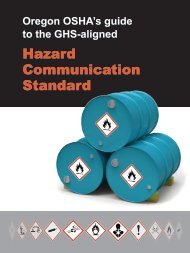Technical Manual - Section 3 (Safety Hazards)
Technical Manual - Section 3 (Safety Hazards)
Technical Manual - Section 3 (Safety Hazards)
Create successful ePaper yourself
Turn your PDF publications into a flip-book with our unique Google optimized e-Paper software.
INDUSTRY RECOMMENDATIONS<br />
The American Petroleum Institute (API) in its Specification<br />
4E "Specification for Drilling and Well Servicing Structures"<br />
sets forth a "Recommended Guying Pattern General<br />
Conditions."<br />
The Association of Oilwell Servicing Contractors. (AOSC) in<br />
its publication "Recommended Safe Procedures and<br />
Guidelines for Oil and Gas Well Servicing" recommends the<br />
same guying patterns as are set forth in API Specification 4E.<br />
Though not present in the AOSC publication the API<br />
Specification 4E provides a Recommended Guyline Anchor<br />
Spacing and Load Chart. This is discussed in detail in the<br />
Guidelines on the Stability of Well Servicing Derricks.<br />
There has been considerable progress within the industry to<br />
design procedures to assure the integrity of the stability<br />
system without the necessity of conducting individual pull<br />
tests on each of the anchors.<br />
APPLICATION<br />
This chapter is intended to form the basis of a minimum<br />
safety guideline, for the use of Temporary Guywire Anchor<br />
Systems on derricks, in the oil well drilling and servicing<br />
industry.<br />
Recommended procedures, practices, equipment, and<br />
requirements have been developed based on availability,<br />
capability, adaptability, dependability, and reliability of the<br />
various types of systems.<br />
B. TYPES OF GUYWIRE ANCHORS<br />
MANUFACTURED ANCHORS<br />
There are four basic types of manufactured anchors. The<br />
screw or helix anchor, expanding plate anchor, flat plate<br />
anchor, and the pivoting anchor. Holding capacity of these<br />
anchors varies; detailed information on holding capacity,<br />
comparison charts with illustrations, and characteristics<br />
specific to each design may be found in <strong>Section</strong> 2 of the<br />
support manual.<br />
When installed in conformance with manufacturer<br />
specifications and evidence thereof is provided, this would<br />
satisfy the requirement for individual pull testing.<br />
CAUTION: It should continually be emphasized that the<br />
anchor is only one component of the Rig Stability<br />
System(RSS)<br />
Screw- (helix-) type anchors have a direct correlation between<br />
anchor capacity and the torque required to install the anchor.<br />
Following the manufacturer's specific recommendations as to<br />
torquing, with proof thereof, is a valid method of determining<br />
anchor holding capacity. Torquing according to<br />
manufacturer's<br />
specifications is an acceptable nonpull-test method of<br />
determining anchor capacity.<br />
SHOP-MADE (IN-HOUSE FABRICATED)<br />
ANCHORS<br />
These anchors should be designed by a registered engineer<br />
and conform to accepted engineering practices. Written<br />
procedures shall be established for installation.<br />
These manufactured anchors should be proof tested for<br />
structural integrity and holding capacity. Records shall be<br />
maintained of test protocols and holding capacity based on<br />
soil type.<br />
Individual pull testing will not be required if anchors are<br />
installed in accordance with written procedures. Proof thereof<br />
will be required of installation protocols and proof-tested<br />
holding capacities.<br />
III:1-2
















